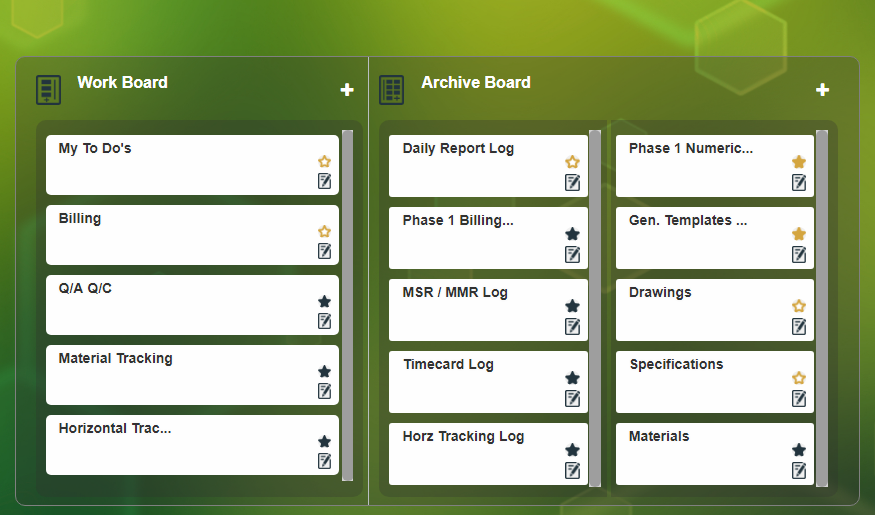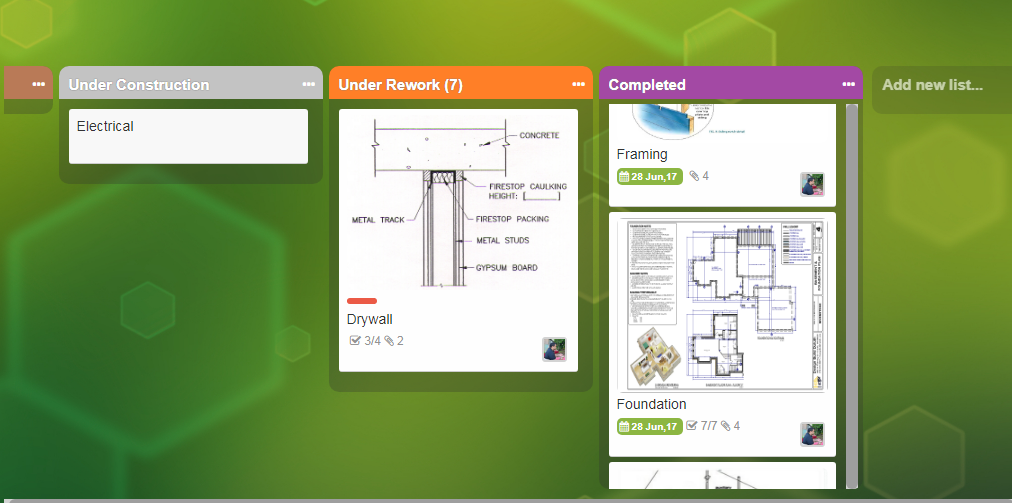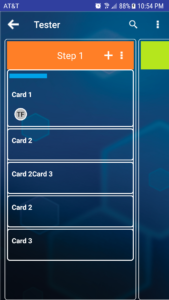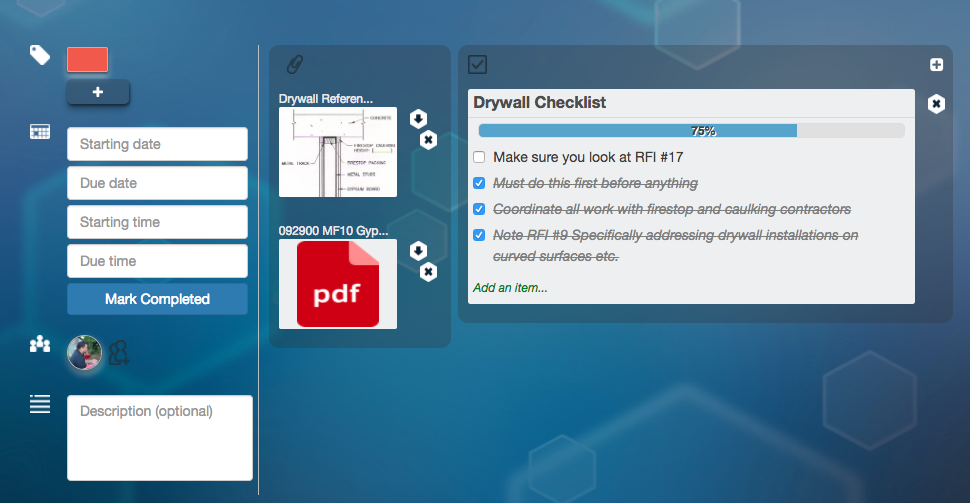Impact of Kanban Construction Software on Project Management
October 4, 2017
Kanban Construction Software can revolutionize the way construction projects are approached and managed.When I began looking into building a construction management platform, I looked for a governing concept users could easily understand to minimize learning pains. (Click here to read my previous article discussing what I was looking for in detail) I selected Kanban for this very point. However, I soon realized Kanban provided much more than I could have imagined in adopting a Kanban interface.
The core benefits of a Kanban-based construction management platform:
-
Simple & Relatable.
The Kanban interface is extremely simple. Imagine a whiteboard with Columns and sticky notes, if you are familiar with these 3 things you are familiar with the Kanban Construction Software Interface. The first column on left is your “To Do” list, the final column is your “Completed” list. Each column between your “To Do” list and “Completed” list represents a company’s internal processes. The sticky notes are the specific construction activities derived from contract specifications, document control, financial tracking etc. The sticky notes are also referred to as cards. The simple acts of creating columns/lists, naming sticky notes , and moving sticky notes between columns/lists are mirrored in the Kanban Based Construction Software.
“The Kanban interface is extremely simple. Imagine a whiteboard with Columns and sticky notes, if you are familiar with these 3 things you are familiar with the Kanban Construction Software Interface.”
-
Task Management.
These digital sticky notes (cards) can be directly assigned to a specific individual in the construction team within the software platform. Effectively every task within the construction project can have a specific person responsible for that task. Just like a physical board team members can visually see each card/sticky note, its current location on the board, and who is assigned to each activity. This visual of current project activities are very useful for Project Managers / Executives, especially if they are managing the project remotely. Within a couple minutes of looking at a Kanban Board, a manager can easily understand the status of each activity, and team members responsible for the activities.

A view of Work Boards and Archive Boards from a testing Sandbox of an early version of the Kanban Construction Software. The picture shows a portion of the Project View. Each Work Board represents a specific team’s “whiteboard” when clicked, the view changes to show the board details, what the team’s “columns” or lists are, and the different tasks (sticky notes/cards) currently being worked on. Archive Boards are boards where teams can log completed tasks for quick reference, and serves as a digital drive to store documents online e.g. drawings, specifications, pictures etc. Executives and Managers can quickly assess where specific tasks are in the process of completion and who is directly responsible for each task, this is all done in a simple yet powerful visual manner.
-
Collaboration.
The Kanban approach is highly collaborative. Multiple team members can be assigned to a single task or multiple tasks. Team members can attach documents related to the construction task such as specifications, contract drawings, pictures from the field etc. Checklists are created within the sticky note/card and marked off as the work is completed. Any member of the card or board is notified and made aware of changes.
-
Cloud File Storage.
I created a new type of Kanban Board that primarily serves as a means to log completed activities and to store files on the Platform. This new type of boards is called “Archive Boards”. Archive Boards serve as simple way Project teams can log completed items and store any type of files in the cloud such as specifications, drawings, RFI’s, Submittals etc. This effectively allows any construction firm to digitize their contract documents and internal company logs in the cloud, for easy access via internet browser and mobile application.
” Majority of construction employees are not aware of the processes a company has in place for executing work, this is not just a construction problem but an issue businesses in general suffer. This lack of understanding internal processes causes 2 main problems. First, employees never learn the company processes. Second, company processes cannot be improved so the same mistakes are repeated continuously. The visual Kanban approach of visually representing internal company processes allows companies to quickly teach internal processes.”
-
Kaizen Naturally Embedded.
The Kaizen philosophy focuses on continual improvement within an organization from top to bottom. Majority of construction employees are not aware of the processes a company has in place for executing work, this is not just a construction problem but an issue businesses in general suffer. This lack of understanding internal processes causes 2 main problems. First, employees never learn the company processes. Second, company processes cannot be improved so the same mistakes are repeated continuously. The visual Kanban approach of visually representing internal company processes allows companies to quickly teach internal processes. This leads to employees quickly learning company internal processes allowing for not only improvement but avoiding the same pitfalls over and over. These visual representations allows employees to make adjustments to processes to fit particular needs or to increase productivity. Management can visually see the ideas of employees in action, and if they are beneficial, management can track and implement company-wide. If there are concerns with the new processes implemented by employees, managers can visually assess, ask questions, and ensure that potential pitfalls are avoided. The Kanban approach involves everyone within an organization in the learning and innovating of a construction company’s processes, promoting a Kaizen approach of continual improvement.

A view of the Digital Kanban Board for task management and collaboration in managing a construction project. Here you see the “columns” that are named for the specific process or steps a construction activity is passed through in order to be considered complete being. Each rectangular item is the “Sticky Notes” or Card where specific construction activities are represented. The user can drag and drop the “Sticky Notes” or Cards from one column/list to another to represent which step in the process it is currently located until it is complete.
-
Lean Construction = Kanban
There is constant talk about “Lean Construction” but there is no construction platform that truly implements Lean Principles at every level. Lean as defined by the Lean Enterprise Institute established by James P. Womack and Daniel T. Jones needs to meet 5 characteristics Create Value, Map the Value Stream, Create Flow, Establish Pull, and Seek Perfection.
“Kanban Construction Software allows the owner(s) to collaborate and interact directly as much as needed for a specific construction activity with the team that will be working on the specific construction activity.”
A Kanban based construction software platform has these 5 Lean principles at its core:
-
- Create Value. Value is referred to what value is in the eyes of the customer. First, what adds value from the customer’s point of view must be understood. Second, this knowledge of what the customer values, needs to be disseminated to all team members of the construction team (contractors, architects, engineers, suppliers etc). Kanban Construction Software allows the owner(s) to collaborate and interact directly as much as needed for a specific construction activity with the team that will be working on the specific construction activity. The entire team can share this information with all team members through the Kanban Board to ensure everyone has access to this information.This maximizes the probability of not only meeting the customers value expectation but also of exceeding the value expectation is the customer.
- Map Value Stream. Value stream directly refers to the steps or processes the team must take to achieve the customer’s expected value. Kanban Boards are created by Mapping out processes construction activities must pass through in order to be considered complete, waste can be identified in this process planning/mapping phase.
- Create Flow. As work is accomplished through the Mapped Value Stream, unforeseen waste is discovered hindering the workflow of completing construction tasks. These are often referred to as “bottlenecks”. These bottlenecks are identified and processes are modified to accomplish flow so that construction work activities and processes pass through the Kanban Board as smoothly as possible i.e. flow. The less resistance there is move activities through the Kanban Board from “To Do” to “Complete” the less amount of waste there is in a company’s processes.

Screen shot from the first version of the mobile application 0f our Kanban Construction Software Technology. This view shows the board columns and sticky notes Kanban Interface.
4. Establish Pull. This is having an activity ready or completed in the shortest amount of time as possible. That is whenever the team is ready to Pull / Request / Start the specific work activity. With waste removed Value Mapping and inefficiencies rectified the Creation of Flow via Kanban the time to move an activity from “To Do” to “Completed” is minimized.
5. Seek Perfection. This comes back to the previously mentioned point of Kaizen where the ability to continually improve by involving innovation from top to bottom and visualizing a construction company’s processes to easily identify areas for improvement allows an organization to Seek Perfection

This shows what the digital “sticky Notes look like and how they can be a great way to consolidate information for a specific construction activity. We can see that a detail drawing is attached, a checklist of items that should be considered and reviewed for the activity, Due Dates, Team members assigned to the activity and also a labeling system for filtering and tracking. One of the tools in a Kanban Construction Software that can impact Project Management in all 5 Lean Principles.
-
It soon became apparent that our platform could reach far beyond construction as well, and improve every business effort looking to improve in implementing simple/Relatable software, improve task management, increase collaboration, manage business documents in the cloud, infuse Kaizen & Lean principles into their business processes.

